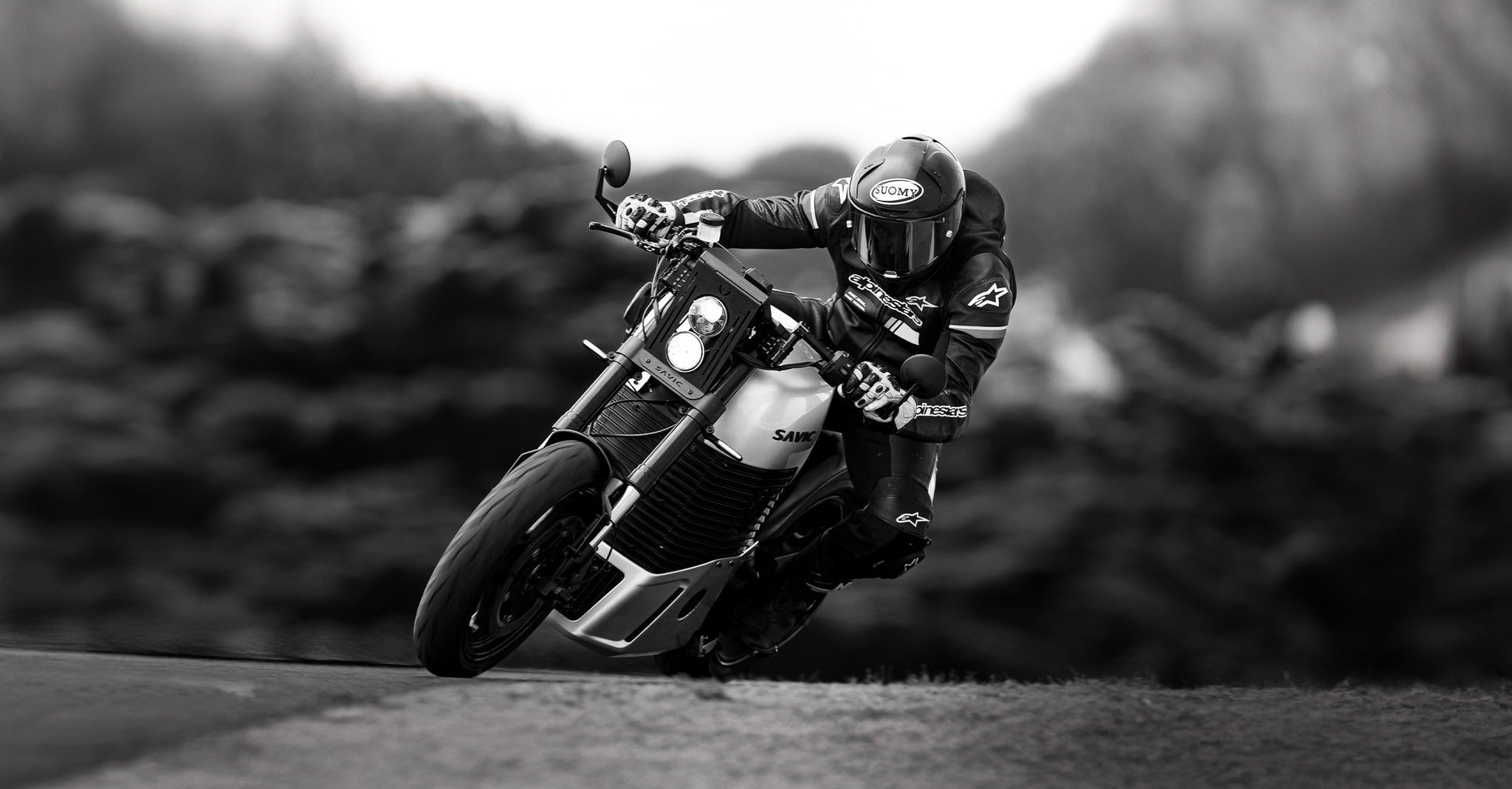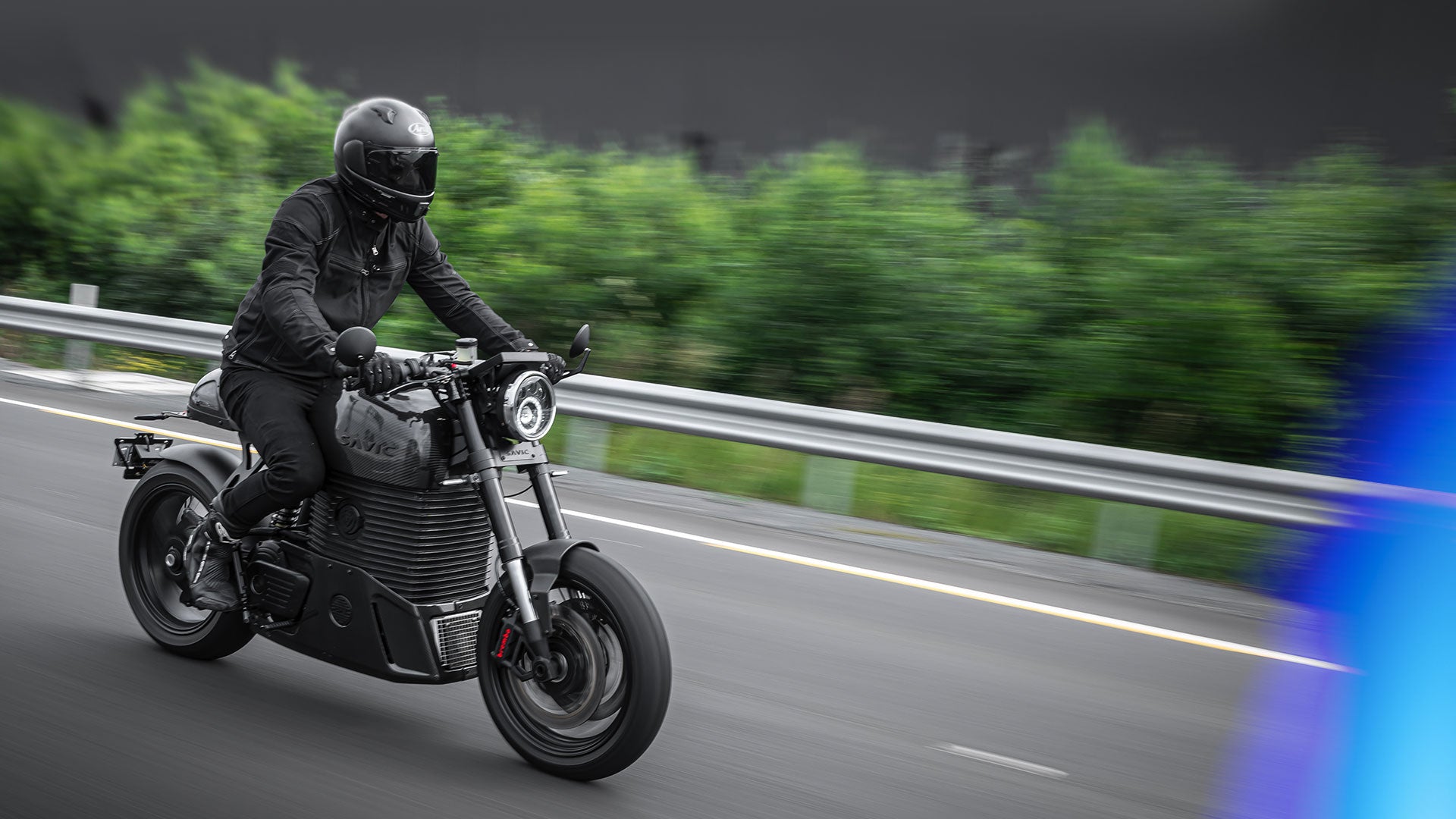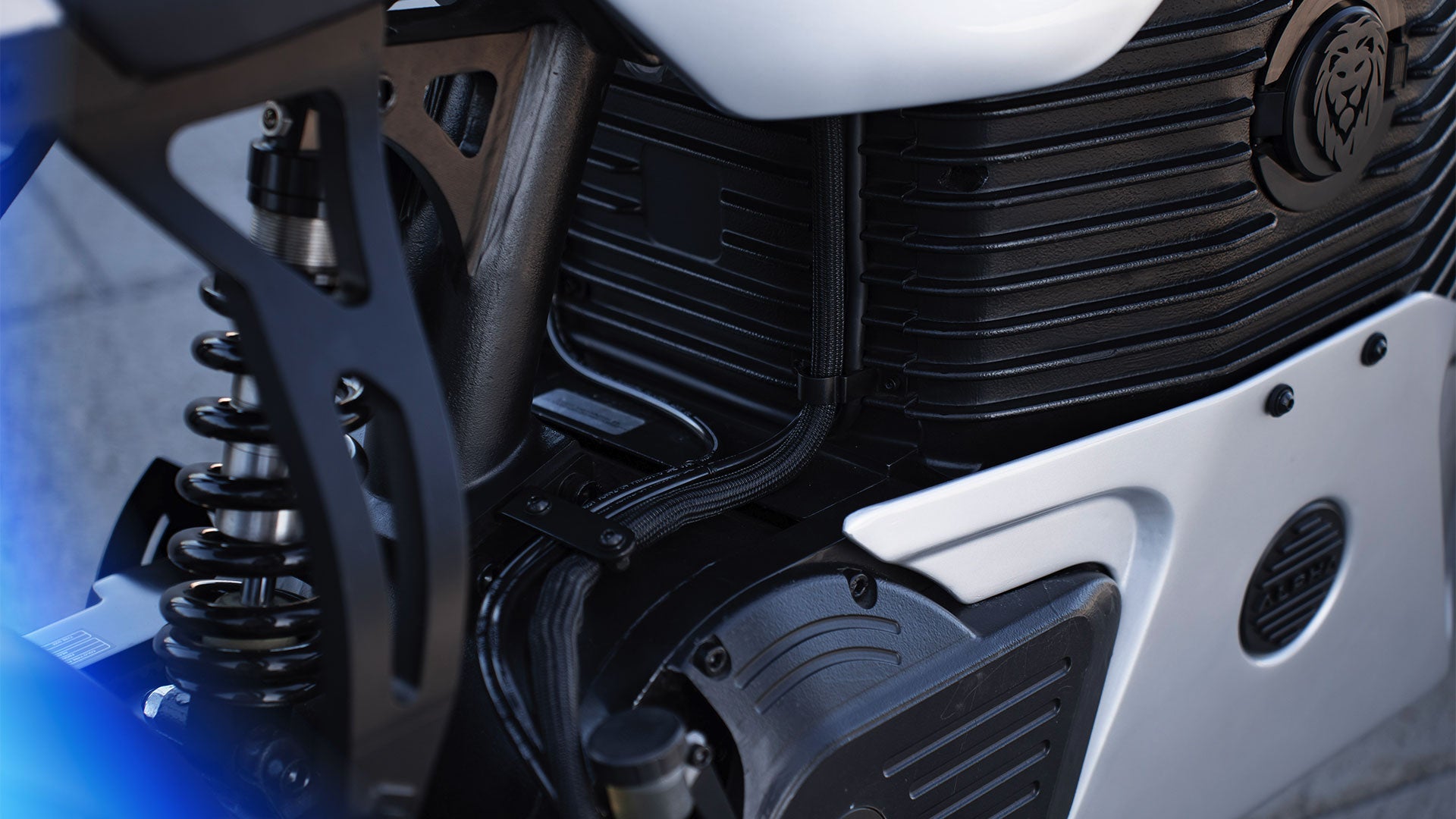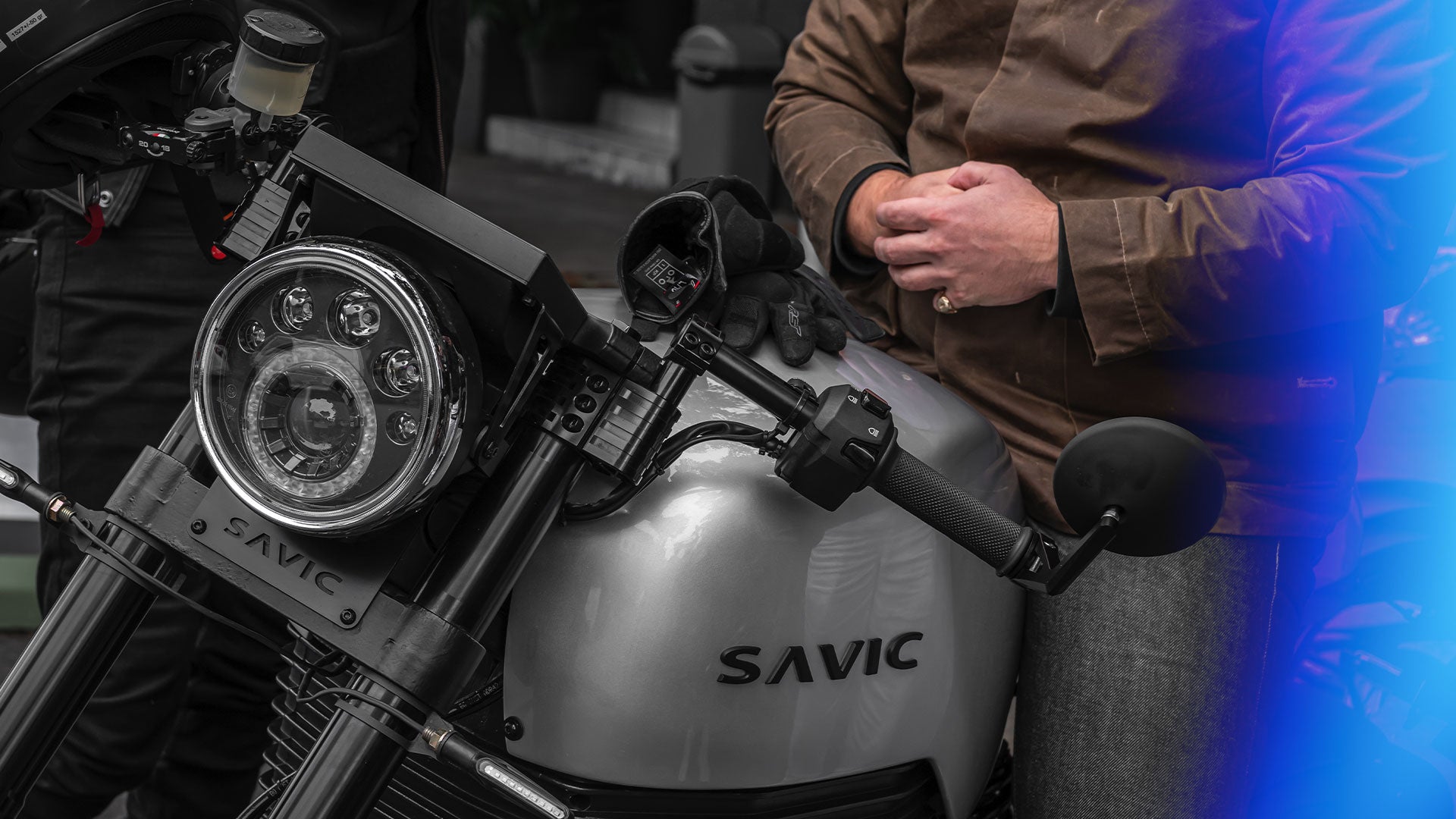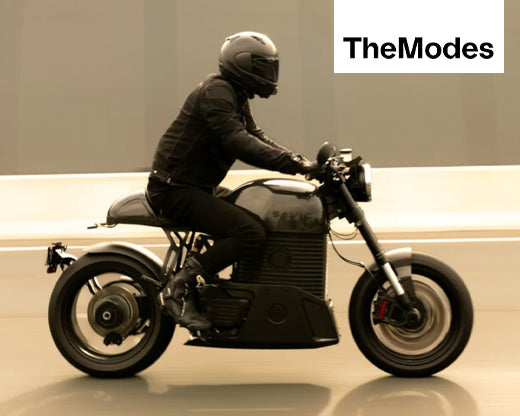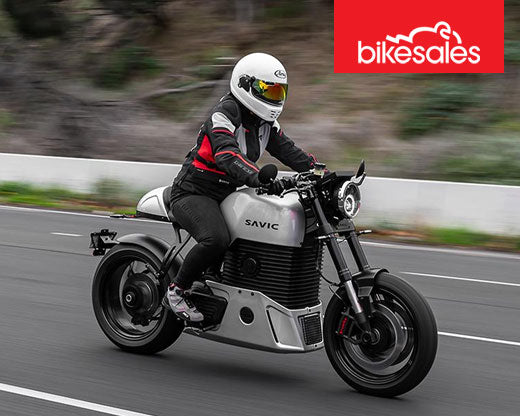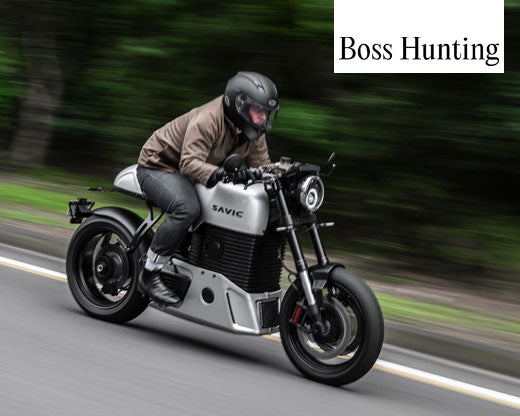
Originally Published: 12th June 2025
ROAD TEST: SAVIC C-SERIES
Test: David “Davo” Johnson | Photography: Mark Boxer
SILENT THUNDER
TT legend Davo Johnson already put the Savic C-Series through its paces on a racetrack. Now it’s time to tackle the real world …
Sitting at the traffic lights in dead silence, I could hear people talking as they pointed at my motorcycle. Some were going “What is that?”, some were saying “Wow, is that an electric bike?”, some were just smiling at the chance to see something different on the road after spending all day at the Adelaide Motorsport Festival that had featured everything from F1 racers to drift cars.
To demonstrate that this wasn’t some underpowered city bike, I gave it an extra tweak as I took off. On a bike with 200Nm of torque (some 50Nm more than a Suzuki Hayabusa) that goes from zero to 100km/h in around 3.5sec, it’s not hard to get off the line like you mean it.
There’s no doubt that the Savic C-Series looks distinctive and different. It will cause people to take a second look anywhere you ride it. They should do anyway, just to check out the build quality and effort put into producing an Australian-designed and assembled motorcycle.
I’d spent the previous two days riding a C-Series around part of Adelaide’s old F1 car circuit as part of the annual Motorsport Festival [check that article out here]. Fellow Isle of Man TT racer Brian McCormack was on another C-Series and we’d done the obligatory burnouts (we had to, as 30 drift cars had been around before us) and chased each other across the circuit in several 15-minute sessions.
I was impressed with the overall performance. However, there is a big difference between hammering around a racetrack on either full throttle or hard braking and riding around in the city or out in the hills.
Savic Motorcycles founder Dennis Savic was so keen for me to get the full picture that he made a C-Series available for me straight after my last track session. So now here I was, riding it home for a couple of days of real-world testing.
When AMCN last rode a Savic on the street (a pre-production version), the main complaints were its suspension that dived and wallowed under brakes, with the front cowl even hitting the ground under extreme braking, and the lack of acceleration compared to its rivals at the time (the LiveWire and Energica).
My sessions on the track proved that the Savic team has fully sorted the suspension and power output. As I reported in my Quick Spin article, the handling was excellent, despite the 280kg weight. Under extreme braking, the suspension took up travel quickly without any hint of it bottoming out. On a 10 per cent lean angle going into a corner, I reckon I was at 90 per cent braking effort, then 100 per cent as I pulled it upright into the apex.

PERFECT STREET CRUISER
The plan was to meet photographer mate Mark Boxer mid-morning during the week and head up to the Adelaide Hills for a few hours before spending some time in the city’s trendy East End – which seemed like how a typical C-Series owner might spend a day.
Let’s be clear: this bike is aimed at true riders, not posers, and as such has plenty of performance to match its stand-out styling.
Before I set off from home, I sat on the bike for a couple of minutes to make sure I knew how everything worked and how I was going to ride it. I ride, test and race a lot of different motorcycles, so this is something I always do. I suggest everyone should do this to get into the zone of riding.
There’s nothing particularly complicated about the C-Series, except that there is no clutch or gearbox, so you have to put that out of your mind.
Some sportsbikes/superbikes have so many gizmos to work out but not the C-Series. Its 7-inch digital dashboard with a touchscreen gives you all the vital information, such as battery charge and what ride mode you have set (Normal, Sport, Eco or Rain). The four riding modes can be customised and include a cruise control option.
The C-Series connects to the cloud via a 4G connection. This means you can receive alerts for maintenance and over-the-air electronic management updates. You can also track your bike’s location when parked, monitor the progress of its charging and read a log of your ride statistics. You enable keyless ignition via your smartphone.
Riding through the suburbs to Gorge Road, which would take us deep into the Hills, I found the C-Series to be the perfect street cruiser. Its upright riding position and weight distribution make it easy to ride in the lower city speed zones. It hides its 280kg weight well – similar to big cruisers like Harley-Davidson’s Softail range.
It was comfortable and easy to ride but if I owned one I’d put clip-on bars and rear-set race footpegs to take more advantage of its sports performance. This would make it even more of a sports bike in the Hills.
I chose Gorge Road because it’s one of South Australia’s most famous “motorcycle roads”. Dating back to 1920, it winds from the suburbs along part of the Torrens River with overhanging rock outcrops and up past one of the city’s water reservoirs into orchards and small farms. It has a mix of road conditions, from hairpins with some gravel on them, bumpy sections and then smooth, flowing sweepers near the reservoir – which was part of an elevation upgrade in the 1960s. It’s best to ride this road during the week and outside commuting hours, when traffic is less busy.
At first it felt a bit weird not having to change gear but I soon worked it out after a few corners. You just wind the throttle on and off according to the conditions. The torque, which feels endless, pushes you on.
The C-Series actually felt pretty much like a conventional sports bike and its weight seemed to help with “engine braking” into the hairpins.
This so-called regenerative braking uses the electric motor to feed current back into the battery to help it recharge what you’ve used under acceleration. The process creates torque in the opposite direction of rear-wheel travel, which slows the bike. The level of retardation can be set on the touchscreen.
Front brakes are dual Brembo M4 radial-mounted Monoblocks with 320mm discs. They work as well as you’d expect. Savic has developed the ABS in conjunction with Bosch Australia.
Gorge Road’s changing surfaces certainly put the C-Series to the test but, like on the racetrack, it soaked up all the dips and bumps with not a hint of suspension wallow or twitch in the steering.
Since 2022, the Savic team has worked with ex-racer Jed Metcher to develop the suspension from bought-in components to an in-house designed system that has involved over 100,000km of testing, mostly at the Lang Lang test track southeast of Melbourne. The result is an increase in ground clearance, compliance and handling that hasn’t compromised the seat height. The C-Series has evolved over seven years and six prototypes to get to where it is now.
HEATING UP
One area of concern was the possibility of power being reduced as the day got hotter. This had happened on the racetrack but all was fine on the open road, even though I was riding the C-Series in full-power Sport mode. But I wasn’t using full throttle like I did on the racetrack.
The C-Series motor and inverter is liquid-cooled by a single-loop system that pumps coolant through a radiator (like an electric car) with a fan extracting heat when the bike is stopped or being charged.
Back in the city I parked up for a break in Rundle Street’s coffee strip. As I started to explain to Mark Boxer how well the C-Series handled despite its weight, I thought the best thing to do was a 360° turn across this fairly narrow road.
You can see how easy it was on the video at amcn.com.au/video/. A feet-up circle with no need to drag the rear brake like you might on a heavyweight cruiser. I think a lot of this has to do with the 1440mm wheelbase (which is similar to a Ducati Panigale V2). No doubt this was another factor in its ability to turn quickly and easily in the hairpins on Gorge Road.
Regarding battery usage, I rode the C-Series from 10am to 5pm with a few breaks along the way. The battery level dropped but not to a critical level. This particular bike didn’t have the latest customer monitoring software so I don’t think it’s fair to make a judgment. I never used full throttle, as there’s so much torque, and the re-gen system was helping top up the battery in the corners.
When I got home I used reverse gear to help manoeuvre the C-Series into my garage. A very handy feature. Next day, when the solar panels were powering my swimming pool filter pump, they were also putting charge back into the C-Series. It isn’t compatible with a DC fast-charger, so the best way to describe the system is to say that anywhere you can charge your smartphone you can charge a C-Series. Savic claims four hours 0–80% charging through a 15-amp outlet or at a public charging station. If you charge at home, expect it to take seven hours 0–80%. The C-Series comes with a 10-amp charging cable.
VERDICT
So what’s my verdict on the Savic C-Series? I like the styling and it’s obviously built to a high standard and has had heaps of development put into it. I’ll never be a full electric convert as I love my two-stroke and four-stroke engines too much. But, styled more as a track-day bike, I’d certainly have one in my shed of motorcycles.
Attribution
This article originally appeared in Australian Motorcycle News (AMCN), Print Edition Vol. 74 No. 20 (12 June – 2 July 2025).
Words: David "Davo" Johnson
Photography: Mark Boxer
Reproduced with permission. All rights reserved to the original publisher.
